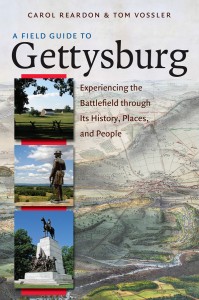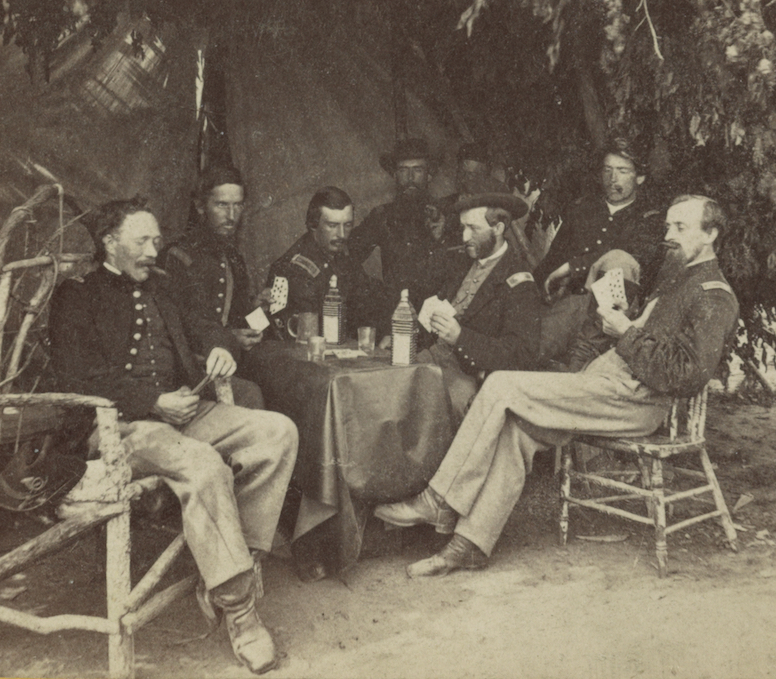A Field Guide to Gettysburg: Experiencing the Battlefield through its History, Places, and People by Carol Reardon and William T. Vossler. University of North Carolina Press, 2013. Paper, ISBN: 0807835250. $22.00.
 This is the second collaboration between Carol Reardon, a professor of military history at Penn State University, and Tom Vossler, a retired Army colonel and licensed Gettysburg battlefield guide since 1998. Their first effort was The Gettysburg Campaign, a short account of the battle for the U.S. Army Center of Military History. We are fortunate that this book is much more widely available: It is both an extremely useful resource for making one’s way intelligently across the battleground as well as a stirring account of the battle and its varied meanings in the past and present.
This is the second collaboration between Carol Reardon, a professor of military history at Penn State University, and Tom Vossler, a retired Army colonel and licensed Gettysburg battlefield guide since 1998. Their first effort was The Gettysburg Campaign, a short account of the battle for the U.S. Army Center of Military History. We are fortunate that this book is much more widely available: It is both an extremely useful resource for making one’s way intelligently across the battleground as well as a stirring account of the battle and its varied meanings in the past and present.
The distinction between the book as a tool for exploring the Gettysburg battlefield and the description it gives of the battle is of course an artificial one. Indeed, one strength of this book is how it weaves together guidance for moving through the battle ground with vivid interpretations of what happened. Nevertheless, dividing my discussion this way allows a better explanation how Reardon and Vossler have accomplished something truly exceptional.
As a tool for exploring the battlefield, this book more than earns its title denomination of “field guide.” Both Gettysburg newcomers and veteran visitors will benefit greatly from it. The tour offered in this book consists of thirty-five stops on the battlefield, organized by major actions during the battle’s three days. The table of contents arranges the tour by the days of battle; also, within each day’s events are useful thematic headings that further organize the tour stops.
For example, there are 12 stops for the fighting that occurred on July 1, 1863. The stops are organized by three major thematic headings: “The Meeting Engagement,” “The Battle is Joined and Expands,” and “The Union Line Collapses.” Under each heading are multiple stops with informative and compelling subheadings such as “The Death of Reynolds,” “Bucktails verses Tar Heels on McPherson’s Ridge,” and “Last Stand at the Seminary.”
The authors also include a map that shows the entire tour (8). The result is an organization that works equally well for those who want to tour the whole battlefield or who want to concentrate on certain events or parts of the battlefield.
Each tour stop begins by orienting visitors to the landscape’s key features and identifies key visual landmarks. Then visitors are taken through six major questions about the stop: What happened here? Who fought here? Who commanded here? Who fell here? Who lived here? What did they say about it later? (The authors introduce these questions in the section “How to Use This Book,” which also includes a wealth of background information about a range of important topics such as prewar Gettysburg, the organization of the Union and Confederate armies, and key controversies about the battle (7-20).)
Contemporaneous and present-day photographs as well as detailed but uncluttered maps give visitors additional helpful information about where they are and what they are looking at. At stops where the battle action was especially complex, the visit is broken down into multiple steps, each with clear orientations and easy to follow directions for walking or driving from one to the other.
Equally valuable is this book’s multilayered account of what happened during the battle and how those events were remembered by participants and witnesses. As such, Reardon and Vossler succeed admirably in achieving two of their stated goals: to help visitors “gain a better appreciation for the complexities of mid-nineteenth-century combat from the perspectives of both the senior leaders and privates in the ranks” and to realize “the challenges facing historians who seek to uncover and ideal called historical ‘truth’ in the midst of Gettysburg’s myriad voices and assessments” (20).
Reardon and Vossler skillfully employ a range of texts, particularly “source material generated in 1863 just before, during, and soon after the battle itself” (7), to give visitors an illuminating introduction to the battle while also drawing needed attention to problems related to fully comprehending what happened at Gettysburg. In addition, they demonstrate that the effort to understand the battle’s events and meaning is something that everyone, from the participants themselves to present-day scholars and visitors, is part of.
The book’s exploration of Little Round Top (Stop 18, 192-210) is a prime example of all its virtues. The section begins by identifying a specific rock on the northwest slope of the hill from which visitors can best see the location of fighting between Confederates and Sickles’ III Corps, Devil’s Den, the Wheatfield, the main Union line on Cemetery Ridge, Cemetery Hill, and Culp’s Hill. The text also explains how to identify the Eternal Light Peace Memorial by using various landmarks, something that helps visitors appreciate the size of the battlefield (194-95).
The stop is then broken into three positions, each clearly identified on a map that also shows the initial position of the units involved in the July 2 fighting (198). The accompanying text helpfully explains the movements of these units, always in reference to the place at which visitors are standing at a given time.
The authors detail the complex and confusing action here with clear, energetic prose. They are particularly good at incorporating veterans’ accounts into their narrative. For example, the just-in-time arrival of the 140th New York to save the right of the Union line comes alive with a survivor’s account of how “the Rebels were nearly to the top of the hill before us” but the Federals had to stand exposed to gunfire like hail for a few moments as they loaded their weapons because no one had ordered them to load before charging to the rescue (200).
As with the other stops, this section includes moving, well researched accounts of individual soldiers’ lives and, often, deaths. I suspect even the most experienced Gettysburg visitor will learn new and valuable things in, for example, the account given of Alabamian Rube Franks’ death in the charge up Little Round Top. He was just back in the line from leave, “his gladsome face beaming as if his sweetheart’s kiss had just materialized on his lips, calling his comrades ‘Come on, boys; come on!’” Or in how New Yorker Sanford O. Webb went from being a young man who worked on neighbors’ farms before the war to support his widowed mother and invalid brother to someone remembered decades later as the first of his company to die on the hill (202-03).
The section, finally, demonstrates that the battle is subject to disputed and conflicting recollections. Controversy about the conduct of the 16th Michigan is usefully summarized (203), just as the text documents that no one really knows where Colonel Vincent was fatally wounded (203-04). Reardon and Vossler also do the important service of reminding us that, regardless of the mythology concerning Joshua Lawrence Chamberlain and the 20th Maine set forth by the novel The Killer Angels and the film Gettysburg, the participants themselves never agreed as to what happened in their repulse of the Confederates (209-10).
Reardon and Vossler conclude their book with the observation that “[e]ven if modern scholarship has eroded the validity of the battle as the single most decisive ‘turning point of the war’ . . . popular memory still accords Gettysburg’s fields, farms, and woods a special place” (418). This unique book enables all readers to better comprehend the places, events, and memories that make up the battle of Gettysburg. As such, no matter how limited or extensive one’s Civil War library, it deserves a special place on the shelf.
Thom Bassett is a lecturer in the Department of English and Cultural Studies at Bryant University. His essays and reviews have appeared in The Civil War Monitor. He is a regular contributor to the New York Times’ “Disunion” online series, and his work is included in the anthology Disunion: Moderns Historians Revisit and Reconsider the Civil War from Lincoln’s Election to the Emancipation Proclamation (2013). He is at work on a novel.
